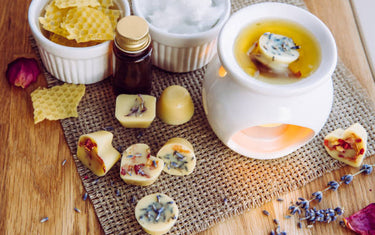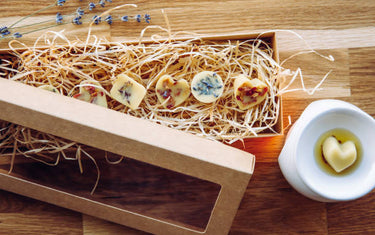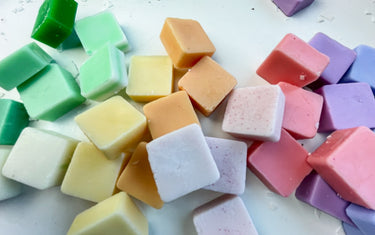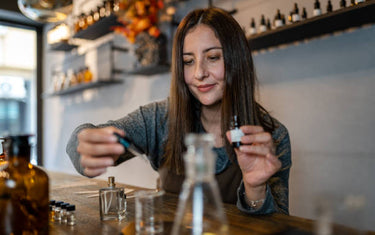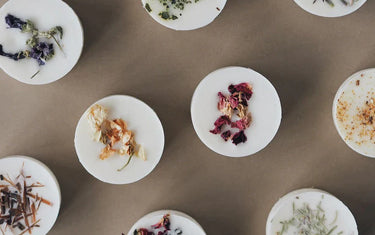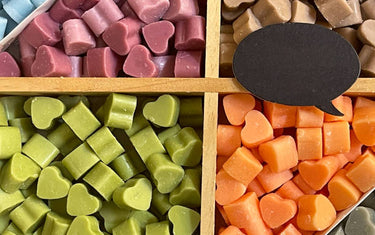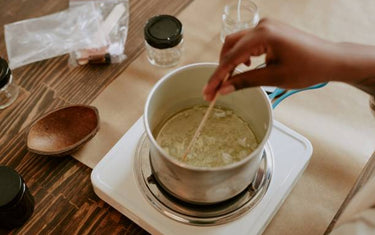5 min read / 24 February 2025 / yasmin sharp
9. Wax Melts Advanced Techniques
Exploring Natural Wax, Custom Moulds, and Sustainable Sourcing.

Perhaps you've dabbled in the art of making your own wax melts before, or maybe you're simply looking to dive straight into some advanced techniques.
Either way, our guide will help you refine your skills and look at how to make natural wax melts, alongside the benefits of custom moulds.
We'll also discuss the importance of sustainable sourcing for eco-friendly wax melts. First, let's take a look at natural waxes.

Natural Wax Melts: A Healthier and Eco-Friendly Option
Why Natural Wax?
Natural waxes such as beeswax, soy, and coconut wax are gaining popularity for good reasons. They offer many benefits compared to traditional paraffin wax. By opting for natural options, you’re choosing a product that is:
- Eco-friendly: Natural waxes come from renewable resources. They’re biodegradable, causing less harm to the environment compared to synthetic options.
- Cleaner burning: These waxes produce less soot, which helps in maintaining better indoor air quality.
- Healthier: Free from the chemicals present in paraffin wax, natural wax melts are a safer choice for homes and families.
Types of Natural Wax
Soy Wax
Soy wax is a popular choice for making natural wax melts. It’s biodegradable and comes from a renewable source, making it an environmentally responsible option. Soy wax melts also tend to burn cleaner and longer, offering a cost-effective yet sustainable product.
Beeswax
Beeswax has a natural honey scent and has a longer burn time than other types of wax. This natural wax has air-purifying qualities due to its ability to neutralise airborne toxins, making it a favourite for people who prioritise air quality in their homes.
Coconut Wax
Coconut wax offers a soft texture and an excellent scent throw. It’s often blended with other waxes to achieve a balanced product. While it's only slightly more expensive, it's perceived to be more of a premium wax.
How to Make Natural Wax Melts
If you’re curious about how to make your own eco-friendly wax melts, follow this straightforward method:
Ingredients
- 500g of soy wax,
- 15ml of fragrance oil or essential oil (phthalate-free)
- optional mica powder for colour
Step-by-Step Process:
- Melt the soy wax: Use a double boiler to melt your soy wax. Make sure the temperature stays around 70°C.
- Add fragrance or essential oil: When your wax is fully melted, take it away from the heat and stir in your fragrance oil of choice, such as our Black Opium fragrance oil or vanilla fragrance oil. Mix thoroughly to distribute the scent evenly.
- Pour into moulds: Pour the mixture into silicone moulds of your choice and leave it to set for at least 24 hours.
- Add colour (optional): For an extra touch, you can include mica powder for a shimmering effect in your natural wax melts.
Challenges with Natural Wax
While natural waxes are a great choice, they come with their own set of challenges:
- Frosting: Soy wax can sometimes develop a white, frosted appearance. This is a natural occurrence and does not affect the performance of your eco-friendly wax melts.
- Cost: Natural waxes such as beeswax and coconut wax can be more expensive than paraffin. This may affect your product pricing if you’re creating organic wax melts for sale.

Custom Moulds and Designs: Bringing Creativity to Wax Melts
Why Go Custom?
Not only are custom moulds fun, but they will help you make some unique designs that stand out in a competitive market. Personalised shapes and patterns also add value, whether you’re creating eco-friendly wax melts for gifts, special occasions, or seasonal collections.
Types of Moulds Available
Silicone Moulds
Silicone moulds are a popular choice as they are both flexible and reusable.
They’re easy to work with and can be used to create intricate shapes and patterns. This gives you much more creative freedom, especially if you want to make detailed designs.
Metal or Plastic Moulds
Metal or plastic moulds are more durable but can be restrictive when aiming for highly detailed designs. However, they are useful for more straightforward shapes and are often used in large-scale production.
DIY Custom Mould Techniques
Silicone Putty
Creating your own custom moulds using silicone putty is a straightforward process. Simply press the putty around an object of your choice, let it set, and you’ll have a reusable mould.
3D Printing
If you have access to a 3D printer, you can design unique moulds using CAD software. This method opens up endless possibilities for intricate designs and detailed patterns.
Pro Tips for Designing with Wax Melts
Designing with wax melts requires some creativity and a bit of practice. Here are a few tips to get started:
- Experiment with Colours: Mixing different colours can result in stunning visual effects. Layering waxes can create layered wax melts that have a professional finish. You can also use mica powder to create mica wax melts.
- Innovative Techniques: For those looking to push their creative boundaries, try making gel wax melts or scoopable wax melts. These offer unique textures and add a creative edge to your product line.

Sustainable and Ethical Sourcing: Making a Difference
Why Sustainable Sourcing Matters
Many of us today are more aware of the environmental impact of our purchases than ever before. As a result, the demand for sustainably sourced products is increasing.
Choosing sustainable wax melt ingredients can help your brand appeal to eco-conscious buyers and set you apart from the competition. Just make sure you stick to the correct advertising laws when marketing your product.
How to Source Ethically
Sustainably Harvested Waxes
Look for certifications such as Fair Trade for beeswax or USDA Organic for soy wax. If you choose to use palm wax, ensure it is RSPO-certified to verify that it has been sourced responsibly.
Eco-Friendly Fragrance Oils
Select natural, phthalate-free oils to minimise environmental impact and reduce potential health risks from synthetic additives. Consumers are increasingly wary of artificial fragrances, so choosing eco-friendly options can make your product more appealing.
Mica Powder for Wax Melts
When using mica powder in wax melts, it’s essential to choose options that are ethically sourced. Mica powder adds a shimmering finish to wax melts, but it’s crucial to select suppliers who prioritise fair working conditions and environmental responsibility.
Packaging and Sustainability
If you want sustainability to be at the forefront of your wax melts product line, then you'll need some eco-friendly packaging to go with it. Here are some options you could consider:
Biodegradable or Recycled Materials
Opt for packaging that is either biodegradable or made from recycled content. This helps reduce waste and aligns with an eco-friendly brand image.
Reusable Containers
Offer eco-friendly wax melts in reusable glass jars or metal tins. This reduces the use of single-use plastics and encourages customers to repurpose the containers.

In Summary
Advancing your wax melt techniques using natural waxes, custom moulds, and sustainable sourcing practices can boost your product’s appeal and eco-friendliness. No matter what your goal is, experimenting with different types of wax and innovative designs will help you create a brand you're proud of.
If you're looking to save money on wax melt supplies, then sign up for a Nikura wholesale account. You'll get access to exclusive discounts that can potentially help you lower your operating costs.

